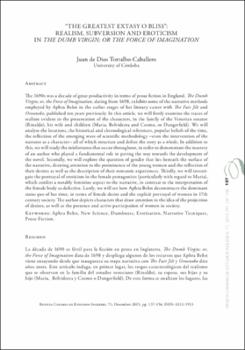“The Greatest Extasy or Bliss”: Realism, Subversion and Eroticism in The Dumb Virgin; or The Force of Imagination
Fecha
2015Resumen
La década de 1690 es fértil para la ficción en prosa en Inglaterra. The Dumb Virgin; or, the Force of Imagination data de 1698 y despliega algunos de los recursos que Aphra Behn viene ensayando desde que inaugurara su etapa narrativa con The Fair Jilt y Oroonoko diez años antes. Este artículo indaga, en primer lugar, los rasgos caracterológicos del realismo que se observan en la familia del senador veneciano (Rinaldo), su esposa, sus hijas y su hijo (Maria, Belvideera y Cosmo o Dangerfield). De esta forma se analizan los lugares, las coordenadas temporales e históricas, las creencias populares, el reflejo de la nueva ciencia e incluso la intervención de la narradora como personaje los cuales enmarcan y modelan la ficción. Asimismo se estudian las adversidades que tienen lugar a lo largo del relato para de esta forma dar cuenta de la maestría literaria de la escritora que allana el camino hacia la novela. En segundo lugar, se ahonda en las cuestiones de género que subyacen al tejido textual de la obra señalando el protagonismo de las jóvenes, el reflejo de sus deseos así como la articulación de su enamoramiento. En tercer lugar, se investiga la plasmación de la erotización en la figura de las protagonistas (concretamente en la persona de María) que aporta un ingrediente notable de la femineidad, frente a la interpretación que considera al cuerpo de la mujer como defectuoso. Finalmente, se infiere cómo Aphra Behn deconstruye el statu quo imperante en la época en lo que atañe al deseo femenino así como a la explicitación de la mujer en la sociedad del siglo XVII ya que genera unas actantes que capitalizan precisamente la proyección del deseo, la presencia de la mujer en la sociedad y su participación activa. The 1690s was a decade of great productivity in terms of prose fiction in England. The Dumb Virgin; or, the Force of Imagination, dating from 1698, exhibits some of the narrative methods employed by Aphra Behn in the earlier stages of her literary career with The Fair Jilt and Oroonoko, published ten years previously. In this article, we will firstly examine the traces of realism evident in the presentation of the characters, in the family of the Venetian senator (Rinaldo), his wife and children (Maria, Belvideera and Cosmo, or Dangerfield). We will analyse the locations, the historical and chronological references, popular beliefs of the time, the reflection of the emerging wave of scientific methodology –even the intervention of the narrator as a character– all of which structure and define the story as a whole. In addition to this, we will study the misfortunes that occur throughout, in order to demonstrate the mastery of an author who played a fundamental role in paving the way towards the development of the novel. Secondly, we will explore the question of gender that lies beneath the surface of the narrative, drawing attention to the prominence of the young women and the reflection of their desires as well as the description of their romantic experiences. Thirdly, we will investigate the portrayal of eroticism in the female protagonists (particularly with regard to Maria), which confers a notably feminine aspect to the narrative, in contrast to the interpretation of the female body as defective. Lastly, we will see how Aphra Behn deconstructs the dominant status quo of her time, in terms of female desire and the explicit portrayal of women in 17th century society. The author depicts characters that draw attention to the idea of the projection of desires, as well as the presence and active participation of women in society.





